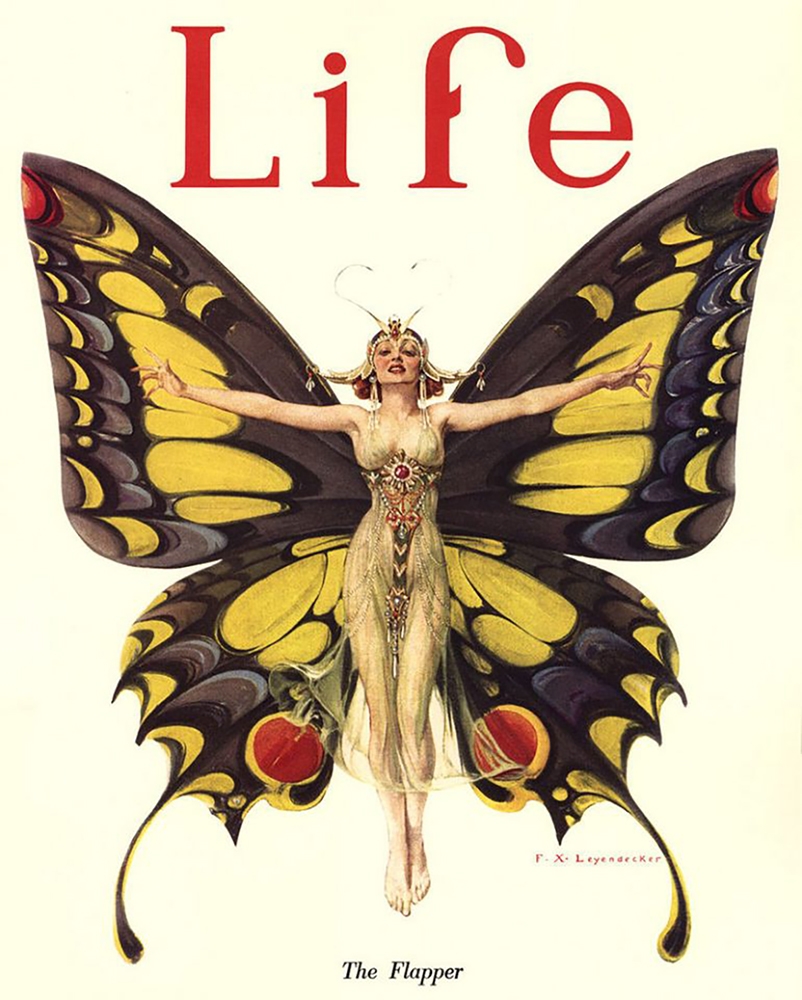Winner of the Fall 2016 StMU History Media Award for
Best Article in the Category of “Culture”
When one thinks of the 1920’s era one immediately thinks about Flappers. A flapper was considered a young woman who was very fashionable. This was a young female who enjoyed life to the fullest, flouting her unconventional standards of behavior and carefree party lifestyle.1 The spirit behind this movement was all about leaving the traditional ways of life behind and transforming into an independent woman.

Before World War I, the concept of femininity was referred to as the Gibson Girl. This term was used to describe these new independent and often well educated women. Gibson girls wore their hair long, pinned up and adorned with beautiful hats. They completed their ensemble by wearing long skirts and blouses that buttoned up to their necks. Despite their feminine appearance, these women were more than capable of doing the same things that men did. Examples of this include activities such as playing sports: skating, golfing, bicycling, tennis. These young ladies did not go out until they were asked properly by a young man who had good intentions and a promise of marrying them. Gibson Girls soon broke away from their traditional ways.2
In 1915, two years before America’s entry into World War I, a famous author by the name of H.L. Mencken introduced the word “Flapper” to the United States. Mencken stated that a flapper was “a woman who consumed music, literature and periodicals voraciously taking her cues for behavior and style from the media in front of her rather than the moral codes of decorum.”3 Another famous author, F. Scott Fitzgerald, famous for his classic novel The Great Gatsby, described the flapper as “lovely, expensive, and about nineteen.” John Held Jr., who was an American cartoonist, emphasized the flapper by drawing young girls wearing unbuckled galoshes that would make a “flapping” noise when walking.4 Despite the many different terms, Flappers were described essentially the same way: they were young girls who enjoyed the party life and had a sense of fashion.
After World War I ended in 1918, many things had changed for the men returning home, particularly the roles and values that women were embracing. The traditional values were gone and in their place came a faster, sleeker, and more daring approach to life. This time period not only ushered in an era of change in values, but it also established a new baseline for what was considered feminine. The Flapper Age was born and it brought with it a new and independent woman. These women smoked, drank, voted, cut their hair into bobs, wore eyeliner, and went to as many parties as they could—enjoying every bit of the social life along the way.5

During the 1920’s, fashion changed drastically due to a very famous designer, Coco Chanel. This woman helped flapper fashion to stand on its own. Typical flapper clothing included a simple sack like dress, which allowed women of all classes to make their own dresses and remain on trend.6 The waist of the dress was dropped to the hipline, and the skirt fell just below the knee. Stockings made of rayon were added and worn over a garter belt. To complete the look, bracelets were added and necklaces ran from the neck to the waist. Cloche hats sat atop their heads and drew the eye into a new hairstyle trend known as the bob.7 The make-up of flappers consisted of a red powder or cream that was used for the lips and cheek, eye-liner, powder for the face, and red lipstick that became very popular.
On January 19, 1919, the Eighteenth Amendment, also known as the Volstead Act, came into effect and gave way to the Prohibition Era in which the sale, production, importation, and transportation of alcohol was banned across the nation.8 This change in the legal system caused the sale and consumption of liquor and alcohol to go underground. The most rebellious thing a flapper could do at this time was to consume alcohol, and these young girls had a reputation for being giddy. The following year, on August 18, 1920, the Nineteenth Amendment was passed and women now had the right to vote.9 In 1924, the first radio launched more than 600 commercial channels around the U.S. The radio at the time was the social media on the flapper life. Many young girls swarmed the theaters to see the image of the flapper on screen. Famous actress Clara Bow, starred in the “Flapper” and made the look iconic.
On December 2, 1927, Henry Ford invented the Model A vehicle and car sales increased.10 Women were now owners of vehicles, and the car became a lifeline to a world full of excitement for the flapper in particular. With no one to stop them, they were free to come and go as they pleased. Liberated women were now able to go out and enjoy dancing during this era that was the Jazz Age. The most popular thing for a flapper to do was to go to a nightclub where she would drink, dance, and show off her moves. The era of the Flapper, however, came to an end with the Wall Street Crash of 1929. Many young women lost their jobs and the incomes that had given them such independence.11
Life in the 1920’s left a huge legacy for women to this day. Flappers and the forward-thinking concept of the modern woman is what initiated the change in society for how women were viewed then as well as how they continue to be viewed in present day. With their bold choice in attire, along with their new views and attitudes regarding femininity, both in fashion as well as social conduct, Flappers left behind the old traditional ways and paved the road for a more liberated female.
- Salem Press Biographical Encyclopedia, January 2016, s.v. “Flappers,” by R.L. Smith. ↵
- Kelly B. Sagert, Flappers: A Guide to an American Subculture (Greenwood Publishing Group, 2010), 1-2. ↵
- Brian DiPaolo, Flappers: Issues & Controversies in American History (Infobase Publishing, 2007), 4-5. ↵
- DiPaolo, Flappers: Issues & Controversies in American History, 4-5. ↵
- Soo Hyun Park, Flapper Fashion In the Context of Cultural Changes of America in the 1920’s (CUNY Academic Works, 2014), 1-2. ↵
- Salem Press Biographical Encyclopedia, January, 2016, s.v. “Flappers,” by R.L. Smith. ↵
- Sagert, Flappers: A Guide to an American Subculture, 3. ↵
- Sagert, Flappers: A Guide to an American Subculture, 5. ↵
- DiPaolo, Flappers: Issues & Controversies in American History, 2. ↵
- F.L. Allen, Only Yesterday: An Informal History of the Nineteen Twenties (National Humanities Center, 1931), 5. ↵
- Alan Brinkley, American History: Connecting with the Past Volume 2, 15 edition (New York: McGraw-Hill Education, 2014), 643. ↵




213 comments
Honoka Sasahara
Today many women like a car or bob hair style or playing sport as hobbies, but there was era where it did not be understood that women do such things. It is unbelievable for me living only in this age. After reading this article, I felt that times have been keeping going and wondered how it’s going to change from now.
Emily Jensen
This article was an interesting read, the images were a really great addition. Flappers are the icon of the 1920s. I agree with the previous comment that it was refreshing to read an article shedding a new light on the way we view flappers. The way that feminism has evolved from then to now is incredible, if only they could see us now!
Eloisa Sanchez Urrea
The 20’s has always been a time that intrigued me. I really admire that women had the bravery to break free of social norms. They were able to move past a time of oppression into one where they took control of their own lives. Women now cut their hair short, went out, and were even finally given the opportunity to vote. This article did a good job of describing that change and had very good images.
Raymond Munoz
Every time I here about how poorly women were treated throughout history I can’t entirely wrap my head around it, probably because of the time and way I was raised. I grew up with two sisters and both my parents, who always reminded me to treat women with the upmost respect and always be a gentleman. So, trying to imagine why women ever had to push to make society see how great they can be is weird to me, because a woman and every human beings value just seems like common sense to me. The emergence of women pushing the boundaries of society in the 1920’s is a true testament to the saying “where there is a will there is a way.”
Crystal Baeza
I loved how this article portrayed a different way flappers are viewed in today’s world. Being a flapper was being a part of a women’s movement to change the way women were viewed at the time. It’s nice reading articles about women empowering each other for the better and seeing how much has changed since then. If it wasn’t the flappers going out of the ordinary women today could have been viewed differently. The article was a great read and I enjoyed reading about all the information of how a flapper came to be.
Luis Magana
The twenties is a time a lot of people have talked about. Women have always been oppressed so its good when they got the opportunity to really be happy and do what someone would say a mans job. These females got the right to vote and it was a big deal.Many things changed after the era of flappers giving the opportunity to women to do or accomplish more things. The article is very well written and I love the images.
Katherine Watson
What I would give to live in such a classical era. The makeup, the glam, the lifestyle is just so captivating that I genuinely feel like I was born into the wrong time period, and then for this to be the start of women empowerment and women’s rights is the cherry on top. Flappers are more than what the current media likes to depict them as, like dancers who were just meant to be arm candy to a man. They are a symbol of equality, and for that, they deserve the recognition of every feminist in this world for they are the beginning of a never-ending fight for equality.
Jennifer Salas
The 20’s has always been era that fascinated me because so much occurred during this time. I remember learning about flappers and just being in awe of them. I love how this article was informative and the writer really caught my attention. I love how women really took control on how they wanted to be perceived and really started to use their voice.I believe that this era really made women think that they were so much more that what they were being labeled as.
Cooper Dubrule
Its interesting to learn about a feminine movement that started in a time when women were barely getting the right to vote. It must be very empowering to be a “Flapper” and it really makes sense based off of the situation they were in. Due to World War 1 women had to take on a more “out of the household” role in society and this showed the masses that it was possible for women to work even when the men came back. This movement contributed to what is known as modern day feminism.
Maxx Arizmendi
During the 1920s, flappers were popular within the media. It can be said that the twenties were a big deal for women all over because there were those women who could do things that society would describe as “a man’s job.” The era of the flappers was pivotal to the women’s rights movement. I thought this article did great describing who and what flappers really are, making it an enjoyable read.